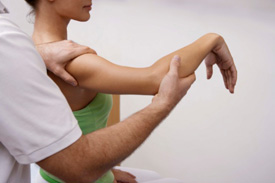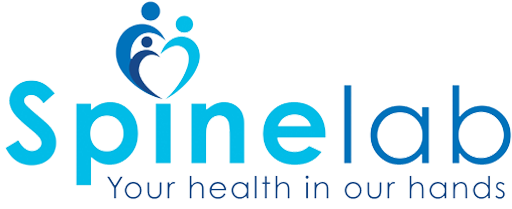Tennis Elbow – Chiropractic Treatment
 Tennis elbow, or lateral epicondylitis, takes its name from a common injury that originally appeared in a high proportion of tennis players. However this condition can present itself in many people who never play tennis at all. Lateral epicondylitis is a painful condition involving the tendons that attach the muscles to the bone on the outside (lateral) part of the elbow. The muscle involved in this condition, the extensor carpi radialis brevis, helps to extend and stabilize the wrist. With lateral epicondylitis, there is degeneration or deformity of the collagen of the tendon’s attachment, weakening the attachment site and placing greater stress on the area. This can then lead to inflammation and pain associated with activities in which this muscle is involved, such as lifting, gripping, and/or grasping. The majority of people who suffer from tennis elbow are between 30 and 60 years old, although the condition can affect much younger athletes as well. Both men and women are also equally affected.
Tennis elbow, or lateral epicondylitis, takes its name from a common injury that originally appeared in a high proportion of tennis players. However this condition can present itself in many people who never play tennis at all. Lateral epicondylitis is a painful condition involving the tendons that attach the muscles to the bone on the outside (lateral) part of the elbow. The muscle involved in this condition, the extensor carpi radialis brevis, helps to extend and stabilize the wrist. With lateral epicondylitis, there is degeneration or deformity of the collagen of the tendon’s attachment, weakening the attachment site and placing greater stress on the area. This can then lead to inflammation and pain associated with activities in which this muscle is involved, such as lifting, gripping, and/or grasping. The majority of people who suffer from tennis elbow are between 30 and 60 years old, although the condition can affect much younger athletes as well. Both men and women are also equally affected.
Causes of Tennis Elbow.
Tennis elbow may occur as a result of repeated extension or overuse of the wrist against resistance such example is using a hammer in the work place and from sporting activities such as tennis, badminton, squash and cricket. Tennis elbow is equally likely to appear in work related activities such as brick laying, carpentry and from the excessive typing on a computer keyboard where repetitive wrist extension occurs.
A poor grip size or backhand technique with a tennis racquet can be a primary cause and commonly seen in the player who miss times his stroke or arrives ‘late’ for a backhand. This means they cannot get their body fully behind the ball. So much of the problem is in the foot work. The wrist has to compensate for poor body positioning and in doing so injuries are caused to muscles and tendons which provide this movement. In addition the wrist needs to be firm and not bent when the ball is struck so the forces can be spread over the arm, shoulder and the body. The wrong racquet grip will mean the muscles in the elbow must work harder leading to damage to the tendon.
Another possible cause of tennis elbow is direct trauma to the elbow which may result in swelling of the tendon that can lead to degeneration. A sudden extreme action, force, or activity could also injure the tendon.
Two types of onset are commonly seen
Sudden Onset: Sudden onset of tennis elbow occurs in a single instance of forced exertion such as a late back hand where the extensors of the wrist become strained. This is thought to correspond to micro-tearing of the tendon.
Late Onset (most common): This normally takes place within 24-72 hours after an intensive overuse of untrained wrist extension. Examples may be a tennis player using a new racket, the wrong grip or even a person who’s spent a weekend doing DIY.
Symptoms of tennis elbow / lateral epicondylitis.
- Severe burning pain from about 1-2 cm down from bony area at the outside of the elbow (lateral epicondyle)
- Weakness in the wrist associated with pain on the outside of the elbow or radiating into the forearm which causes difficulty when performing simple tasks such as gripping a jar, shaking hands, opening the door or using a screwdriver.
- Lifting even very light objects (such as a small book or a cup of coffee) can lead to significant discomfort.
- Pain on the outside of the elbow when the hand is bent back (extended) at the wrist against resistance.
- Pain on the outside of the elbow when trying to straighten the fingers against resistance.
- Pain when pressing just below the lateral bony prominence (epicondyle) on the outside of the elbow.
Non surgical treatment of Tennis elbow.
- Tennis elbow treatment involves treatment not only in the elbow area but also treatment altered motion of the joints in the neck or shoulder. Each individual will react differently to different treatments. Below are examples only- we always recommend seeing a qualified chiropractor before attempting any rehabilitation.
- Ice or cold therapy to the elbow (15 min’s on up to six times a day). This will help reduce pain and inflammation if present.
- Cold laser therapy is shown to be extremely effective in settling down the inflammation and promoting healing of the soft tissues.
- Rest – an extremely important component in the healing of this injury.
- A brace or support will help to protect the tendon whilst healing and will provide strengthening, particularly when returning to playing sport or work equivalent. The brace should not be put on the painful area but rather approximately 10 cm down the forearm.
What can a chiropractor do to help?
- Assess the integrity of the joints in the elbow, the neck and shoulder and address any areas of joint dysfunction as this may alter the nerve supply to the elbow.
- Correctly diagnose the condition: This may be done by carrying out Mills’ test- resisted wrist extension with the palm facing the floor (pronated) and moving the hand sideways in the direction of the thumb. If pain is elicited then this is a positive sign for the test. Another test is to resist extension of the middle finger-pain is also a strong indicator.
- Treat to help reduce pain and inflammation as well as stimulate healing.
- Advice on pain control-such as ice/biofreeze/NSAID’s.
- Apply myofascial release and/or transverse friction techniques across the tendon.
- Identify and correct any predisposing factors which lead to the onset of tennis elbow. Get some lessons; your tennis coach should also be able to provide some advice with regards your backhand technique.
- If the conservative treatments have failed for about a year then referral to the orthopaedic surgeon may be considered.
How long will Tennis Elbow take to get better?
Sometimes tennis elbow may heal quickly within two weeks but some people can suffer with this problem for up to two years. When the pain have settled down it is essential to provide full rehabilitation and strengthening of the elbow.
Top 5 tips on preventing Tennis Elbow.
- Work on the correct technique – play the backhand with the whole body, turning the hips, not just the wrist!
- Use a forearm brace or heat retainer if you have a weak wrist or elbow.
- Use a light racket if you do not play very often
- Do not play with wet, heavy balls
- Make sure that racquet strings are not too tight
